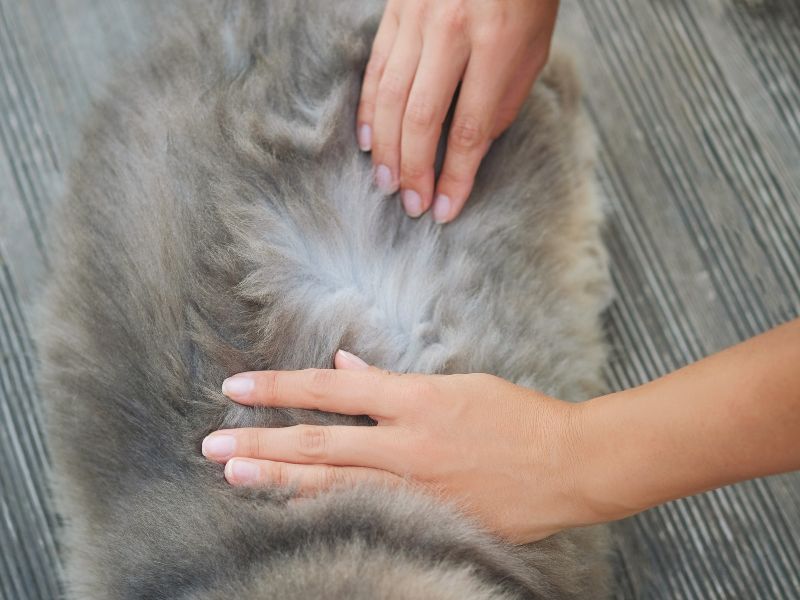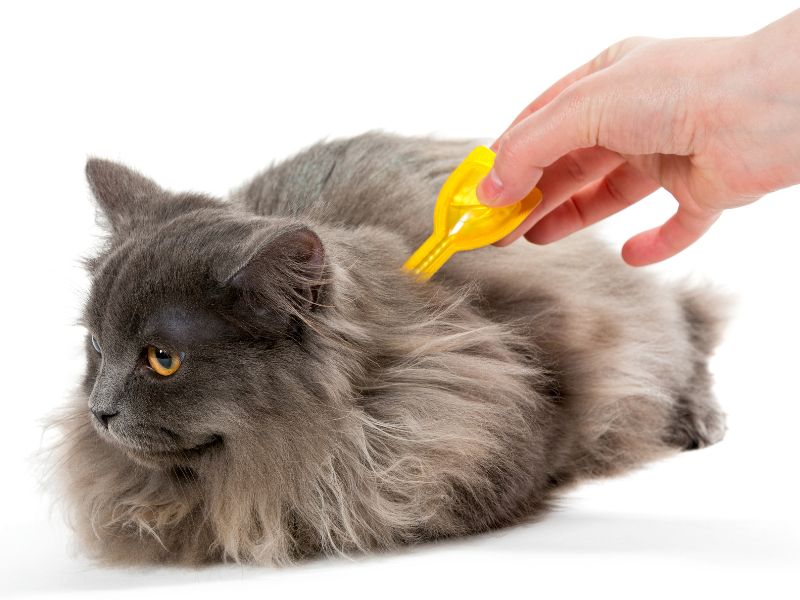Are you tired of dealing with pesky fleas and ticks on your beloved feline friend? Look no further! In this article, we will explore the best ways to prevent these annoying parasites from infesting your cat and your home. Fleas and ticks not only cause discomfort to your cat, but they can also transmit diseases that can be harmful to both animals and humans. By taking proactive measures, you can ensure that your cat remains happy, healthy, and free from these tiny pests. From regular grooming routines to using effective preventive treatments, we will provide you with practical tips and expert advice that will help keep fleas and ticks at bay. So, let’s dive in and discover the secrets to a flea and tick-free cat!
The Importance of Preventing Fleas and Ticks in Cats
Fleas and ticks are more than just a nuisance for your cat. These tiny parasites can cause a range of health problems, from skin irritations and infections to more serious conditions like anemia and Lyme disease. Preventing fleas and ticks is not only about keeping your cat comfortable, but it’s also about safeguarding their overall well-being.
One of the main reasons why prevention is crucial is because these pests reproduce rapidly. A single flea can lay up to 50 eggs per day, which can quickly lead to a full-blown infestation if left unchecked. Ticks, on the other hand, can transmit diseases such as Lyme disease, ehrlichiosis, and babesiosis, which can have severe consequences for your cat’s health. By taking proactive measures to prevent fleas and ticks, you can protect your cat from these potential dangers.
Prevention is also important for the well-being of your entire household. Fleas and ticks can easily infest your home, making it difficult to eradicate them completely. This can lead to constant re-infestations, causing frustration and discomfort for both you and your cat. By implementing preventive measures, you can create a safe and flea-free environment for everyone.
In the following sections, we will delve into the various preventive measures and strategies that you can employ to keep your cat free from fleas and ticks.
Understanding the Life Cycle of Fleas and Ticks
Before we dive into preventive measures, it’s essential to understand the life cycle of fleas and ticks. This knowledge will help you better comprehend their behavior and determine the most effective ways to disrupt their life cycle.
Fleas have a four-stage life cycle: egg, larva, pupa, and adult. Female fleas lay eggs on the host (your cat), which then fall off into the environment, such as your carpets, bedding, or furniture. The eggs hatch into larvae, which feed on organic debris found in their surroundings. After the larval stage, the fleas spin a cocoon and enter the pupal stage. Pupae are resistant to most treatments, making them the most challenging stage to eliminate. Finally, the adult fleas emerge from the cocoon and seek a host to feed on.
Ticks have a simpler life cycle compared to fleas. They have three stages: larva, nymph, and adult. After feeding, female ticks drop off the host to lay eggs, which hatch into larvae. The larvae then feed on a host, molt into nymphs, and continue their feeding cycle. Once the nymphs have fed, they molt into adult ticks and seek another host for their final blood meal before mating and laying eggs.
Understanding the life cycle of fleas and ticks is vital because it allows us to target each stage effectively and interrupt their reproductive cycle. By doing so, we can prevent infestations and keep our cats protected.
Common Signs and Symptoms of Flea and Tick Infestation in Cats
Identifying a flea or tick infestation in your cat early on is key to preventing further complications. Here are some common signs and symptoms to watch out for:
- Excessive scratching and grooming: If you notice your cat scratching or grooming excessively, it could be a sign of fleas or ticks. These pests cause irritation and discomfort, leading to increased scratching and licking.
- Visible fleas or ticks: Fleas are tiny, brown insects that are about the size of a sesame seed. They can be seen scurrying through your cat’s fur. Ticks, on the other hand, are larger and can be easier to spot, especially when they have engorged themselves with blood.
- Red, irritated skin: Flea bites can cause redness and inflammation on your cat’s skin. You may notice small red bumps or raised welts, particularly around the base of the tail or on the neck.
- Hair loss or thinning: Continuous scratching and biting due to flea or tick infestation can lead to hair loss or thinning in certain areas of your cat’s body.
- Pale gums: In severe cases of flea infestations, cats can develop anemia, which is characterized by pale gums. Anemia occurs when fleas feed on your cat’s blood, causing a decrease in red blood cell count.
If you notice any of these signs or suspect that your cat may have fleas or ticks, it’s essential to take immediate action to prevent the infestation from worsening. In the next section, we will explore the preventive measures you can take to keep these pests at bay.

Preventive Measures for Flea and Tick Control
Preventing fleas and ticks is a multi-faceted approach that involves a combination of proactive measures. By implementing these preventive measures, you can significantly reduce the risk of infestation and keep your cat protected. Here are some effective strategies to consider:
Choosing the Right Flea and Tick Prevention Products for Your Cat
When it comes to preventing fleas and ticks, there is a wide range of products available on the market. From topical treatments to oral medications, it’s essential to choose the right product for your cat’s specific needs. Here are some popular options:
- Spot-on treatments: Spot-on treatments are applied directly to your cat’s skin, usually between the shoulder blades. These treatments are highly effective and provide long-lasting protection against fleas and ticks. They work by spreading through the oil glands in your cat’s skin, killing and repelling the parasites.
- Oral medications: Oral medications are another popular option for flea and tick prevention. These medications come in the form of chewable tablets or flavored liquids and are ingested by your cat. They work by circulating through your cat’s bloodstream, killing any fleas or ticks that bite your cat.
- Collars: Flea and tick collars are worn around your cat’s neck and provide continuous protection against these parasites. These collars release a steady stream of active ingredients that repel and kill fleas and ticks. They are a convenient option for cats that dislike topical treatments or oral medications.
When choosing a flea and tick prevention product, it’s essential to consider factors such as your cat’s age, weight, and overall health. Some products may be suitable for adult cats but not for kittens or cats with certain medical conditions. Consulting with your veterinarian is the best way to determine the most appropriate product for your cat.
Natural Remedies for Flea and Tick Prevention
If you prefer to use natural remedies or complement conventional treatments, there are several options available. While natural remedies may not be as potent as conventional products, they can still provide some degree of protection against fleas and ticks. Here are some natural remedies to consider:
- Essential oils: Certain essential oils, such as lavender, cedarwood, and citronella, have natural insect-repellent properties. Diluting these oils with a carrier oil and applying them to your cat’s fur can help repel fleas and ticks. However, it’s important to note that essential oils can be toxic to cats if ingested or applied in concentrated form. Always consult with a veterinarian before using essential oils on your cat.
- Herbal sprays: Herbal sprays made from natural ingredients like rosemary, lemongrass, and neem can be used as a natural flea and tick repellent. These sprays are typically applied to your cat’s fur and can help repel pests.
- Diatomaceous earth: Diatomaceous earth is a fine powder made from fossilized algae. It can be sprinkled on your cat’s bedding, carpets, or other areas where fleas and ticks may be present. Diatomaceous earth works by dehydrating and killing these parasites upon contact.
While natural remedies can be a useful addition to your preventive arsenal, it’s essential to remember that they may not offer the same level of protection as conventional products. It’s always best to use natural remedies in conjunction with other preventive measures for optimal results.
Regular Grooming and Inspection for Early Detection
Regular grooming and inspection of your cat is crucial for early detection of fleas and ticks. By establishing a grooming routine, you can not only keep your cat’s fur clean and healthy but also spot any signs of infestation before it becomes a major problem.
Start by brushing your cat’s fur regularly. This helps remove any loose hair, dirt, or debris that could potentially harbor fleas or ticks. While brushing, pay close attention to areas where these parasites are commonly found, such as the base of the tail, behind the ears, and around the neck. Use a fine-toothed comb to comb through your cat’s fur, checking for any signs of fleas or ticks.
During the grooming process, if you spot any fleas or ticks, it’s important to remove them immediately. Use a pair of tweezers or a specialized tick removal tool to carefully remove ticks from your cat’s skin. It’s essential to grasp the tick as close to the skin as possible and pull it straight out with steady pressure. Avoid twisting or squeezing the tick, as this can increase the risk of leaving parts of the tick embedded in your cat’s skin.
After removing any fleas or ticks, dispose of them in a sealed container or flush them down the toilet. Be sure to clean the area where you found the parasites thoroughly to prevent re-infestation.

See Also: Practical Ways to Help Your Cat Reach Their Ideal Weight
And: Best Practices Caring for Very Old Cats
Environmental Control for Preventing Flea and Tick Infestation
Preventing fleas and ticks goes beyond treating your cat alone. It’s equally important to address the environment in which your cat lives. Fleas and ticks can easily infest your home, so taking measures to control their populations in your surroundings is crucial. Here are some environmental control strategies to consider:
- Regular vacuuming: Vacuum your home regularly, paying particular attention to areas where your cat spends a lot of time, such as carpets, rugs, and upholstery. Vacuuming helps remove flea eggs, larvae, and pupae, reducing the chances of infestation. Remember to empty the vacuum bag or canister promptly to prevent any fleas or ticks from escaping.
- Washing bedding and blankets: Regularly wash your cat’s bedding, blankets, and any other fabric items that your cat comes into contact with. Use hot water and a detergent that is effective against fleas and ticks. High temperatures kill fleas and ticks at all life stages, ensuring that your cat’s belongings are free from these pests.
- Outdoor maintenance: Keep your outdoor environment well-maintained to discourage fleas and ticks from thriving. Trim your lawn regularly, remove any debris or overgrown vegetation, and create a barrier between your yard and neighboring wildlife that may carry fleas or ticks.
- Flea and tick sprays: Use flea and tick sprays specifically designed for your home environment. These sprays can be applied to carpets, rugs, and other areas where fleas and ticks may be present. Follow the instructions on the product label carefully to ensure safe and effective use.
By implementing these environmental control measures, you can significantly reduce the chances of fleas and ticks infesting your home. Remember, prevention is always easier than dealing with a full-blown infestation.
Tips for Keeping Your Cat Safe from Fleas and Ticks When Outdoors
While it’s important to focus on preventing fleas and ticks indoors, it’s equally crucial to protect your cat when they venture outdoors. Here are some tips for keeping your cat safe from fleas and ticks when they are outside:
- Avoid high-risk areas: Fleas and ticks are commonly found in areas with tall grass, dense vegetation, and wooded areas. When possible, keep your cat away from these high-risk areas to reduce the chances of picking up these pests.
- Use flea and tick repellent products: Apply a flea and tick repellent product specifically designed for outdoor use on your cat. These products typically come in the form of sprays or wipes and can provide additional protection when your cat is outside.
- Check for hitchhikers: After your cat has spent time outdoors, thoroughly check their fur for any fleas or ticks that may have hitched a ride. Pay close attention to the areas where these parasites are commonly found, such as the head, neck, and armpits.
- Consider outdoor enclosures: If you have a yard, consider creating an outdoor enclosure or catio for your cat. This allows them to enjoy the outdoors while minimizing their exposure to fleas and ticks.
Remember, even if your cat is primarily indoors, they can still be at risk of fleas and ticks if you have other pets that go outdoors or if you bring these pests into your home on your clothing. Taking preventive measures is essential to keep your cat protected.
The Role of Regular Veterinary Check-ups in Flea and Tick Prevention
Regular veterinary check-ups play a crucial role in flea and tick prevention. Your veterinarian can provide expert advice, recommend the most appropriate preventive products, and conduct thorough examinations to ensure your cat is free from these pests. Here’s how regular veterinary check-ups contribute to flea and tick prevention:
- Health assessment: During a veterinary check-up, your veterinarian will assess your cat’s overall health, including their skin and coat. They will look for any signs of fleas, ticks, or other skin conditions that may require treatment.
- Preventive product recommendation: Your veterinarian can recommend the most suitable flea and tick prevention products based on your cat’s individual needs. They have access to a wide range of products that may not be available over the counter.
- Vaccinations and parasite testing: Regular veterinary check-ups also ensure that your cat is up-to-date on vaccinations, including those that protect against diseases transmitted by fleas and ticks.
Additionally, your veterinarian may recommend routine parasite testing to ensure your cat is free from other unwanted critters. This is especially important if your cat spends time outdoors or interacts with other animals. Routine parasite testing can detect and treat any potential infestations before they become a larger issue. It’s always exciting to know that you are taking proactive steps to keep your furry friend healthy and happy. So, don’t forget to ask your veterinarian about routine parasite testing during your next check-up – your cat will thank you for it!
Conclusion
Fleas and ticks can be a major health concern for cats, but with the right products and preventive strategies, you can protect your pet from these pests. The best way to prevent these pests is to choose the right products for your cat.
While there are many options available, make sure to choose the product that is safe and effective for your pet. Some products are specifically designed to prevent fleas or ticks from infesting your home, while others are designed to treat existing infestations.
Get your cat in on the action by regularly applying topical treatments, like flea collars, spot-ons, or sprays. These products are usually easy-to-use, quick-acting, and highly effective. With regular use, you can prevent fleas and ticks in your cat and your home. Remember, prevention is key to keeping these pests at bay and saving both you and your cat from potential health issues.

